| 1. |
Saran R, Robinson B, Abbott KC, et al. US renal data system 2016 annual data report: epidemiology of kidney disease in the United States. Am J Kidney Dis, 2017, 69(3 Suppl 1): 7-8.
|
| 2. |
The International Diabetes Federation. IDF diabetes atlas, 10th edition R. Belgium: the International Diabetes Federation, 2021.
|
| 3. |
Sinha SK, Nicholas SB. Pathomechanisms of diabetic kidney disease. J Clin Med, 2023, 12(23): 7349.
|
| 4. |
Xu Y, Lu J, Li M, et al. Diabetes in China part 1: epidemiology and risk factors. Lancet Public Health, 2024, 9(12): e1089-e1097.
|
| 5. |
GBD 2021 Diabetes Collaborators. Global, regional, and national burden of diabetes from 1990 to 2021, with projections of prevalence to 2050: a systematic analysis for the global burden of disease study 2021. Lancet, 2023, 402(10397): 203-234.
|
| 6. |
Pan X, Lin X, Huang X, et al. The burden of diabetes-related chronic kidney disease in China from 1990 to 2019. Front Endocrinol (Lausanne), 2022, 13: 892860.
|
| 7. |
Centers for Disease Control and Prevention. National diabetes statistics report, 2022: estimates of diabetes and its burden in the United States R. Atlanta, GA: U. S. Department of Health and Human Services, Centers for Disease Control and Prevention, 2022.
|
| 8. |
Nawata KJH. Estimation of diabetes prevalence, and evaluation of factors affecting blood glucose levels and use of medications in Japan. Health, 2021, 13(12): 1431-1451.
|
| 9. |
GBD 2019 Diseases and Injuries Collaborators. Global burden of 369 diseases and injuries in 204 countries and territories, 1990-2019: a systematic analysis for the global burden of disease study 2019. Lancet, 2020, 396(10258): 1204-1222.
|
| 10. |
The Lancet None. ICD-11. Lancet, 2019, 393(10188): 2275.
|
| 11. |
GBD Chronic Kidney Disease Collaboration. Global, regional, and national burden of chronic kidney disease, 1990-2017: a systematic analysis for the global burden of disease study 2017. Lancet, 2020, 395(10225): 709-733.
|
| 12. |
Bikbov B, Perico N, Remuzzi G, et al. Disparities in chronic kidney disease prevalence among males and females in 195 countries: analysis of the global burden of disease 2016 study. Nephron, 2018, 139(4): 313-318.
|
| 13. |
农晓鑫, 韦盼盼, 李畅, 等. 1990-2019年中国糖尿病肾病患病流行特征分析. 现代预防医学, 2024, 51(11): 1950-1955.
|
| 14. |
唐璇璇, 董邓波, 邹圣强, 等. 1990-2019年中国糖尿病肾病疾病负担分析及发病预测研究. 现代预防医学, 2024, 51(13): 2336-2341, 2392.
|
| 15. |
张玉静, 韩布新. 影响长寿的生物、心理、行为与社会因素. 中国临床心理学杂志, 2016, 24(4): 741-746, 770.
|
| 16. |
国家糖尿病防治规划纲要起草小组. 1996-2000年国家糖尿病防治规划纲要. 中国公共卫生管理, 1996, (2): 123-125.
|
| 17. |
中华医学会糖尿病学分会. 中国糖尿病防治指南(试行本). 中国慢性病预防与控制, 2004, (6): 283-285.
|
| 18. |
中华医学会糖尿病学分会. 中国2型糖尿病防治指南(2020年版). 中华糖尿病杂志, 2021, 13(4): 95.
|
| 19. |
田慧, 李春霖, 纪立农. 中国老年2型糖尿病防治临床指南(2022年版). 中国糖尿病杂志, 2022, 30(1): 2-51.
|
| 20. |
Li J, Zhang X, Zhang M, et al. Urban-rural differences in the association between occupational physical activity and mortality in Chinese working population: evidence from a nationwide cohort study. Lancet Reg Health West Pac, 2024, 46: 101083.
|
| 21. |
黎楚湘, 吴擢春, 徐玲, 等. 我国不同性别患者医疗费用支出的差异. 中国卫生经济, 2006, (2): 46-48.
|
| 22. |
杨建南, 李世云, 严兰兰. 综合医院男性与女性住院病人医疗费用比较分析. 数理医药学杂志, 2011, 24(2): 187-190.
|
| 23. |
严善平. 中国城乡就业率的变化与决定因素—基于1988-2010年中国城镇收入调查数据的实证分析. 劳动经济研究, 2016, (3): 20.
|
| 24. |
国务院. 关于建立新型农村合作医疗制度意见的通知. 2003.
|
| 25. |
国务院. 关于开展城镇居民基本医疗保险试点的指导意见. 2007.
|
| 26. |
国务院. 关于深化医药卫生体制改革的意见. 2009.
|
| 27. |
梁珊珊, 周智华, 李成程, 等. 1990-2019年中国糖尿病疾病负担及发病预测分析. 中国全科医学, 2023, 26(16): 2013-2019.
|




